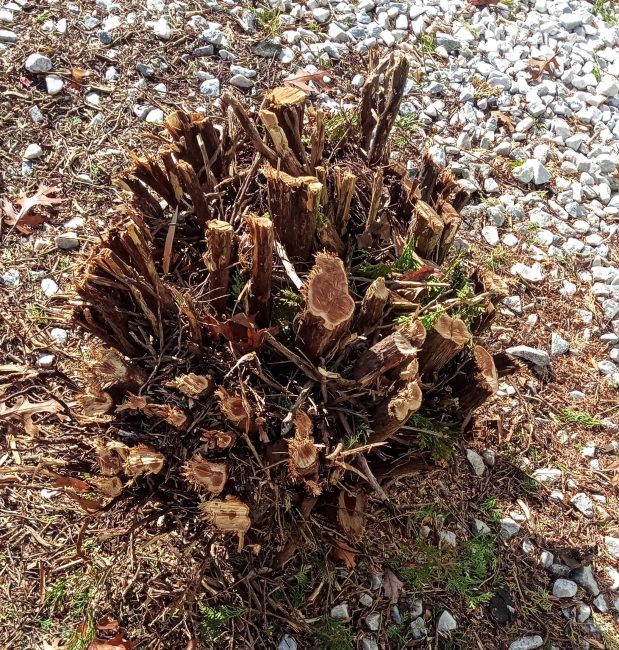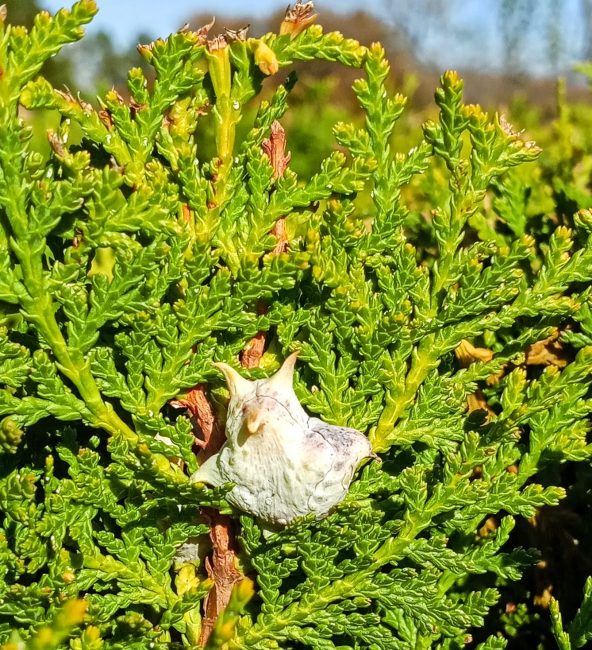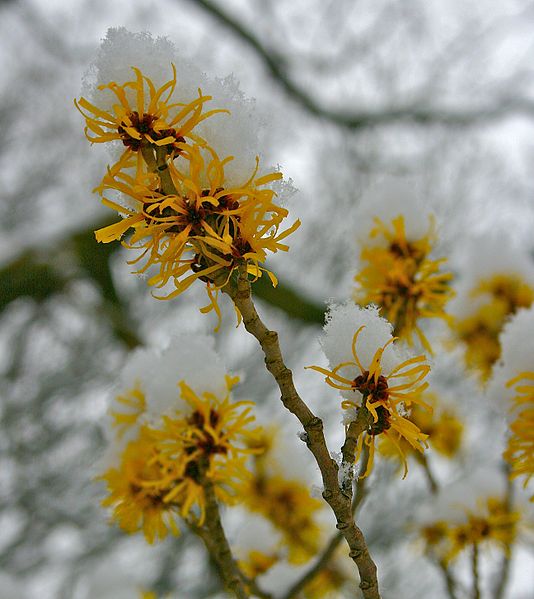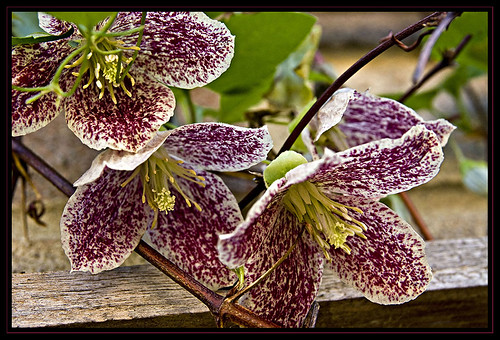I don’t remember if they were there when we moved in, but the shrubs – Thujas – have been around a long time. One article describes their shape as narrow like a pyramid. I guess ours didn’t get that memo. They were wide, rotund almost. And at the end, they stood nearly five feet high. If they’d stayed longer, maybe they would’ve gotten more pyramid-ish shaped. By then, they would’ve been at or above the gutter.

Although they can grow as tall as a tree, shrubs do tend to be wider than taller. What distinguishes a shrub from a tree mostly is the trunk. While a tree generally has a single trunk with branches starting near the top, shrubs have multiple trunks.
I read that, generally, three separate trunks grow into a multi-branched plant. Our Thujas didn’t get that memo either:

Although they were pretty much kept trimmed, they’d grown wide and tall in the past few years. Tall growth around the door of a property makes a great place for someone up to no good to lurk. Their height also blocked the view from inside the house. Then there were the yellowjackets and other wasps and bees who enjoyed them too much. I’m only sorry it deprived the praying mantises of their home.
We talked about trimming – well, cutting them back. Especially since it was time, post-accident, to put up porch and sidewalk railing. Left Thuja pushed out over the sidewalk just enough to be in the way. Cutting it back enough to allow for a useable handrail would leave a mass of brown sticks on view. You’ll see why in the interview below.
The first attempt at cutting it back wasn’t pretty. I’m pretty sure I heard that Thuja smirking ‘What is that – a steak knife?’ The branches aren’t very thick, but they were very solid. Clearly, an aggressive cut-back was not an option.

I thought cutting them down would allow us to start over, that we could aggressively train the new growth to grow in a more contained shape. I was sooo wrong.
ASKING THE EXPERTS
At the 11th hour, I thought to send a question to the Home and Garden Information Center at the University of Maryland Extension. A wonderful resource, one I intend to make better use of! Every state has one; see the table below for Mid-Atlantic options.
When is a shrub done? was my basic question. I quickly received a generously detailed response from HGIC which they’ve graciously allowed me to reproduce here in a Q&A format.
RC: Is it possible to cut the thuja down and then allow it to regrow in a more controlled manner?
HGIC: Many conifers like Thuja cannot replace foliage on old stems such as those present in the lower and interior portions of the plant. It is normal for such plants to lose that inner foliage with age – as the plant matures, the outermost layer of foliage blocks too much light and the inner foliage, being the oldest, has aged to the point where it no longer serves the plant well enough for the plant to keep it alive. (Evergreens do keep foliage for a long time compared to deciduous plants, but not forever, and at some point the oldest leaves are shed. On dense, unpruned plants, this phenomenon is hidden from view.)

RC: We were told that that shrub is dead but I see the little green things growing.
HGIC: Although the remaining outer growth on this Thuja is technically still alive, the shrub as a whole will not be practically salvageable as an aesthetically-pleasing plant and will need removal (which it sounds like you were planning).
The Advent of Yellowjackets
RC: After the first attempt at cutting the shrub, yellowjackets showed up in force. My mom suggested that the sap of the cut wood attracted them?
HGIC: Wasps can be attracted to sap flow for its sugar content, and tend to be most attracted to sugary substances late in the year. Some Yellowjacket species nest in the ground, so it’s also possible they were nesting below the shrub and were agitated by the trimming. (If this is the case, frosts/freezes will kill all of the workers from the colony very soon, and they will not re-use the nest next year.)
Replanting the Area
RC: If we decide to replant, would Thuja’s roots get in the way or serve as mulch for the new plant?
HGIC: In order to replant the area, its root system will need to be removed as well, or at least as much as you can manage to get out since it will be quite tough to extract. You can replant without doing this, but be aware that the remaining underground growth will be in the way of root growth for new plants trying to get established. It will also be in the way of simply digging the appropriate-sized hole for new plantings, especially if any of those plantings are shrubs (versus a smaller perennial). The natural decay of what remains underground of the Thuja may take several years, and while this decay won’t hurt new plantings directly, it may cause the soil in this spot to settle a bit, sinking their root zones and potentially causing them problems.
RC: Is November too late to plant something new?
HGIC: You can still plant now if using deciduous shrubs or perennials, but evergreen installation this late in the season is riskier. Otherwise, you can delay planting until spring, when garden centers/nurseries will have a wider range of options.
RC: Thujas can grow up to 14 feet; everything considered as replacement would do the same. But is it reasonable to train a tall-growing shrub to only reach a small fraction of its potential size?
HGIC: It’s best to pick something that will suit the space, rather than something much larger-growing that has to be repeatedly pruned to fit. Options for replacement are broad and too numerous to list here, since it depends greatly on
- the aesthetic you prefer,
- growing conditions (soil drainage, summer sunlight levels),
- if deer browse nearby, and
- how much room a plant would have to mature before getting too large.
Downspouts, Soil Amendments, and Mulch
RC: Anything else we should consider for this yardspace?
HGIC: We cannot see if a roof downspout empties into this bed, but if one does, this autumn/winter would be a good time to re-direct it elsewhere (and further from the foundation), as few plants tolerate root flooding from this extra influx of water.
If the soil is compacted and clay-based, you can amend it either after Thuja removal or upon planting in spring with compost. If it is otherwise easy to dig in, no amendments would be needed. If any amendments are applied, you would have to remove the stone mulch first in order to get it worked into the soil.
Landscape fabric is often used underneath stone mulches to keep the stone from settling into the soil over time. This too needs to be removed before amending and planting. Both stone and landscape fabric are thought to impede sufficient levels of water and oxygen from reaching roots; so, consider using mulch made of bark or wood chips.
Replacing the Thujas – Wistful Thinking
If I’d checked with HGIC last year, we could’ve saved a trip on a blustery day. Friends took us to a nursery to look at replacement possibilities. Of the available selection were two boxwood varieties – Japanese and Wintergreen. Check out this article from SF Gate to learn the difference between the two.
We could see that uprooting the shrubs was out of the question; cutting the branches was brutal enough, even the chainsaw was given a run for its money. HGIC had this to say about Thuja roots:
“Estimating root spread for any given plant (whether an individual or a species in general) is challenging, as roots respond to conditions both static (such as obstacles like a house foundation) and ever-changing as they grow. Over time, some roots may die off while others replace them, also altering the shape and size of the root system at any snapshot in time.
Overall, tree and shrub roots predominantly grow in the top foot or two of soil depth, as this is where the best oxygen, nutrient, and moisture access is. As such, they spread much wider than they grow deep. How far and in what direction they travel (since it may not be symmetrical) depends in part on
- the age of the plant,
- the compactness of the soil,
- variations in soil moisture,
- competition from weeds or other deliberate plantings, and so forth.
You may need to simply probe the area with a shovel to get a sense of the root system’s extent. Roots decrease in thickness the further they get from the trunk, just like the way above-ground branches get thinner as they grow further from the trunk.
For a plant of this apparent size, roots will be found several feet from the center of the plant. How many survived under the paving is unknown, but they may indeed have made it to the other side (of the front steps at least). Given the tight quarters of this planting location with regards to the pavers/concrete, removal may be challenging if enough roots have grown underneath. They will probably have to be cut instead of removed entirely since the latter may be too impractical.”
Sooo, no uprooting. For now. Possibly forever. I wonder how long before the ground starts sinking as the roots decompose. Years, I’m sure. Oh well, it’s nicer to think of what could’ve been. Like –
Shrubs That Add Color to Winter
When searching for possible replacements, I came across some nice colorful shrubs that can brighten up a winter’s day. Now that would’ve been different. When we first moved in, there were shrubs with spiky leaves and inedible but pretty berries planted around the house. I didn’t like them, was happy to see them go. But shrubs with actual flowers or pretty-colored branches – now that’s interesting! Two that I liked were witch hazel and clematis.
Witch-Hazel (Hamamelis virginiana)

Witch hazel is the main ingredient in my summer cool-down spritzer. It has a long-standing spot in folk medicine (there is some clinical evidence to lend gravitas to those traditional uses). But I never thought of it as a shrub to decorate a yard.
Harvesting my own witch hazel – how sweet would that be! I’d have to redo my Summer Cooler Spritz to work with fresh bark… Ooh, maybe combine the bark and plants as a hydrosol… Oh, but I digress…
Trivia Time – Origin of the Name
According to the wyches, torage chests made from the English
Way back when in England, explains the 1879 American Cyclopedia, a wych was a storage chest made from elm. Because elm leaves look like hazel tree leaves, the elm was called wych elm, then wych hazel. English settlers brought the name to America where they bestowed it on the hamamelis Virginica shrub. So, there you have it – an American shrub named for one English tree that resembled another English tree.
Appearance, Scent, and Size
Witch hazel –
- produces flowers in the yellow to red spectrum
- gives off an earthy or spicy fragrance
- At it’s largest, it can get up to 20’ high and 12’ wide.
Growing it porch-side wouldn’t’ve been a good idea. It would’ve been a better candidate for the back yard where it can stretch out anyways…
Maintenance
It doesn’t require a lot of work and is pretty disease resistant. But some aphids and caterpillars call it home.
Potential for a Home Cash Crop
There’s a nice niche market for selling DIY skin-care products. In time, witch hazel could provide an enterprising soul with a such a product.
Freckles (Clematis cirrhosa var. purpurascens)

Source: Flickr
A flower that blooms mostly while the bees and wasps are hibernating. Very Nice. Freckles can grow up to 12 feet high – okay, so why do we plant things beside the house that could tower over it???
The name comes from ancient Greek meaning climbing plant; it can grow up to 12 feet. The freckles part is evident.
A year after planting, Freckles will bloom between October and March. The bell-shaped flowers have dark red/purple splashes on white.
SHRUB FREE
So our shrub adventure is drawing to a close. It was nice to consider giving the house a new look. It certainly looks larger and brighter without the Thuja twins looming on either side of the porch. Hopefully the small rose bushes will flourish now. And that other interesting plant growing at the corner of the house. When it blooms again, I’ll definitely ask HMIC about it.
So that was our adventure with the ancient Thujas framing our porch. What’s your shrub story?
